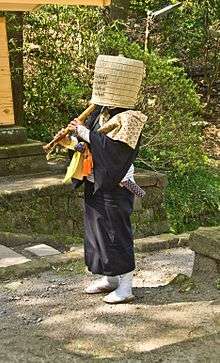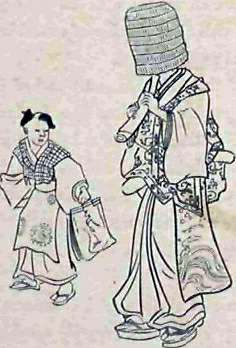Komusō
| Part of a series on |
| Fuke Zen |
|---|
 |
| People |
|
| Philosophy |
| Places |
|
| Topics |
| Literature |
|



The komusō (虚無僧 komusō, hiragana: こむそう; also romanized komusou or komuso) were a group of Japanese mendicant monks of the Fuke school of Zen Buddhism who flourished during the Edo period of 1600-1868.[1] Komusō were characterized by a straw bascinet (a sedge or reed hood named a tengai or tengui) worn on the head, manifesting the absence of specific ego.[2] They were also known for playing solo pieces on the shakuhachi (a type of Japanese bamboo flute). These pieces, called honkyoku ("original pieces"), were played during a meditative practice called suizen, for alms, as a method of attaining enlightenment, and as a healing modality . The Japanese government introduced reforms after the Edo period, abolishing the Fuke sect. Records of the musical repertoire survived, and are being revived in the 21st century .
History
Fuke Zen came to Japan in the 13th century. Komusō belonged to the Fuke sect of Japanese Zen Buddhism. Fuke Zen comes from the teachings of Linji Yixuan, a Zen teacher from China in the 9th century. Fuke, however, is the Japanese name for Puhua, one of Linji's peers and co-founders of his sect. Puhua would walk around ringing a bell to summon others to enlightenment. In Japan, it was thought the shakuhachi could serve this purpose.
Komusō practiced suizen, which is meditation through the meditative blowing of a shakuhachi, as opposed to zazen, which is meditation through quiet sitting as practiced by most Zen followers. Literally meaning "blowing Zen", suizen pieces (known as honkyoku) prioritized precise breathing control as a function of Zen mindfulness and many were designed to be played in time with a monk's footsteps as he marched long distances on pilgrimage. As Fuke Zen increased in popularity through the Sengoku Period, groups of basket-headed komusō playing for hours on street corners or wandering the roadways on pilgrimages became a common sight.
Travel around Japan was heavily restricted by the Ashikaga shogunate during this rebellious era, but the Fuke sect managed to wrangle a rare exemption from the Shogun, since their spiritual practice demanded a mendicant lifestyle of constant pilgrimage, meditative shakuhachi playing and begging for alms (one famous song reflects this mendicant tradition, "Hi fu mi, hachi gaeshi", "One two three, pass the alms bowl"). They persuaded the Shogun to give them "exclusive rights" to play the instrument and travel about the country as they pleased. In return, some were required to spy for the shogunate, which (quickly recognizing the utility of the ruse) also began dispatching their own spies on secret missions in the disguise of komusō.[3] Ninja and ronin (masterless samurai) were also known to travel in the guise of komusō to avoid official scrutiny of their presence or intentions in a province.
Once this became common knowledge, travelers wearing the komusō outfit became subject to closer inspection, especially in restive and disputed areas. Several particularly difficult honkyoku pieces, e.g., Shika no tone, became well known as "tests": if a suspicious komusō was challenged to play one of the test pieces and was able to reproduce it in the authentic suizen manner, he was accepted as an actual Fuke. If he was unable, or if he refused, he was assumed to be a spy and would likely be immediately arrested.
When the Tokugawa Shogunate came into power over a unified Japan at the beginning of the 17th century, the komusō came under official government criticism for the first time. Because many new komusō had formerly been samurai disenfranchised during the Sengoku (Warring States) period (16th century) who were now lay clergy, the potential for trouble was obvious. Because many of the monks were former samurai, and had become rōnin when their masters were defeated—most likely by the Shogunate and their allies—the komusō (now greater in numbers than ever) were seen as untrustworthy and destabilizing to the new shogunate.
Etymology
- 虚無僧 (komusō) means "priest of nothingness" or "monk of emptiness"
- 虚無 (kyomu or komu) means "nothingness, emptiness"
- 虚 (kyo or ko) means "nothing, empty, false"
- 無 (mu) means "nothing, without"
- 僧 (sō) means "priest, monk"
- 虚無 (kyomu or komu) means "nothingness, emptiness"
The priest were known first as komosō, which means "straw-mat monk". Later they became known as komusō, which means "priest of nothingness" or "monk of emptiness". Fuke Zen emphasized pilgrimage and so the sight of wandering komusō was a familiar one in Old Japan.
Flute
The shakuhachi flute was the instrument used to achieve this desired state. The instrument derives its name from its size. Shaku is an old unit of measure close to a foot (30 cm). Hachi means eight, which in this case represents a measure of eight-tenths of a shaku. True shakuhachi are made of bamboo and can be very expensive.
Disguise and outfit
Komusō wore a tengai or tengui (天蓋), a woven straw hat or kasa which completely covered their head like an overturned basket or a kind of woven beehive. The idea was that by wearing such a hat they removed their ego. What the hat also did was remove their identity from prying eyes. Further, the government granted the komusō the rare privilege to freely travel the country without hindrance—playing the flute for alms and meditation. This was because many komusō were spies for the Shogunate; and some were undercover spies, disguised as priests.[4]
- Tengai hat
- Kimono, especially of a five-crested mon-tsuki style
- O-kuwara, a rakusu-like garment worn over the shoulder
- Obi, a sash for men's kimonos
- A secondary shakuhachi to accompany the primary instrument, possibly as a replacement for the samurais' wakizashi
- Netsuke, a container for medicine, tobacco (likely kiseru kizami), and other items
- Kyahan shin coverings
- Tabi socks
- Waraji sandals
- Hachimaki headband, covered by the tengai
- Primary shakuhachi, usually a 1.8 size instrument (I shaku ha sun), pitched in what would today be considered D or D flat
- Tekou hand-and-forearm covers
- Gebako, a box used for collecting alms and holding documents
- Fusa, a tassel
Historical end
After the Tokugawa Shogunate fell to the loyal forces of the Emperor, komusō temples and their priests were abolished in 1871 for meddling in earthly affairs and not the emptiness of being.
References
- ↑ Blomberg, Catharina (1994). The heart of the warrior: origins and religious background of the Samurai System in Feudal Japan. Catharina Blomberg. pp. 101–103. ISBN 1-873410-13-1.
- ↑ Nishiyama, Matsunosuke; Groemer, Gerald (1997). Edo culture: daily life and diversions in urban Japan, 1600-1868. University of Hawaii Press. p. 124. ISBN 0-8248-1736-2.
- ↑ Turnbull, Stephen R. (2005). Warriors of medieval Japan. Osprey publishing. p. 160. ISBN 1-84176-864-2.
- ↑ "Komuso: Japanese Zen Priest", 2008 article by David Michael Weber
- Liner notes from the music CD Komuso: The Healing Art of Zen Shakuhachi, Ronnie Nyogetsu Seldin, shakuhachi. 2000, The Relaxation Company
External links
| Wikimedia Commons has media related to Komusō. |